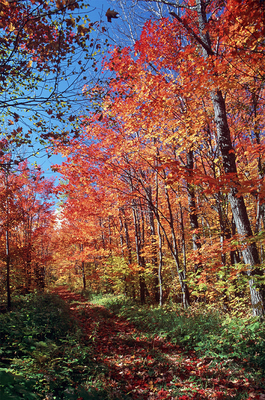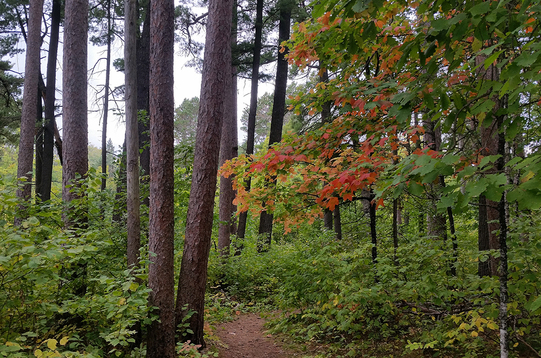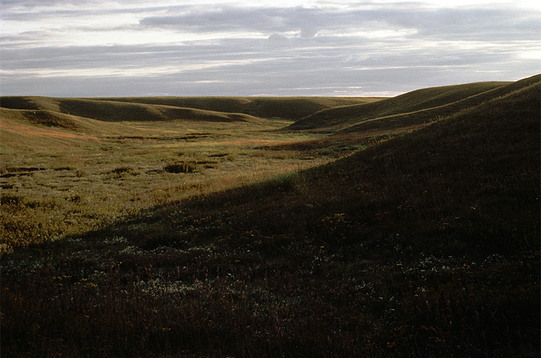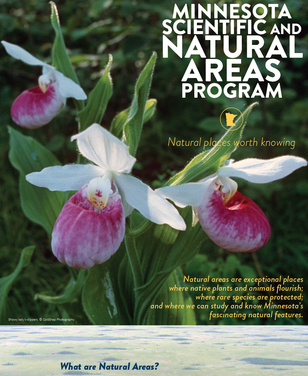 Standouts for Fall Color at Scientific and Natural Areas
By AmberBeth VanNingen,
Northeast Region SNA Specialist, Bryonna Persing, Northeast Region SNA Administrative
Specialist, Cheri Zeppelin, Northeast Region Information Officer, and Kelly Randall, SNA Outreach Coordinator
Minnesota comes alive with fall colors each year as chlorophyll retreats from leaves to reveal underlying bursts of yellow, orange and red. With abundant public land and so many options for great fall color viewing, Minnesota’s Scientific and Naturals Areas are sometimes overlooked as a place to enjoy fall colors.
SNAs are intended to preserve Minnesota’s unique nature. While visitor amenities and recreational uses are limited to protect these wild places, visitors looking for a quiet and simple experience are welcome at SNAs every day of the year. Some SNAs have hiking trails and simple signage to guide visitors through the property, but many are completely undeveloped and offer an untouched, natural experience for those willing to go off-path. Go ahead and chase Minnesota’s fall colors through at the season by starting with these SNAs:
|
Northern Minnesota Mixed Forests, Boundary Waters, and North Shore –
Peak mid-September to early October
-
Iona’s Beach SNA, Castle Danger, MN. The unique natural beach is comprised of pink rhyolite slabs, smoothed by wave action into flattened, shingle-like pebbles. As the waves recede, the shingles come to rest with a tinkling sound unique to this site. Take a walk along the beach or the adjacent Gitchi-Gami State Trail for views of Lake Superior and the highlands in full fall color.
-
Lost 40 SNA, Dora Lake, MN. Spared from logging by a surveying error, the old-growth white pine and red pine forest is considered to be the most significant stand outside of the Boundary Waters and Itasca State Park. Minnesota’s state red pine “Big Tree Champion” is found here and is 120 feet tall with a circumference of 115 inches. A hiking trail winds through the pines and adjacent forests with maples, birches, and tamarack.
-
Lutsen SNA, Lutsen, MN. One of the largest upland old-growth hardwood acreages along the North Shore, where Eagle Mountain, Raven Ridge, and major ridges of the Sawtooth Mountains rise over 800 feet above Lake Superior. Walk the snowmobile (shown in the photo above) or ski trails to immerse yourself in the vibrant sugar maples and birches.
 Color begins to pop along Bohall Trail in the Itasca Wilderness Sanctuary SNA.
Northern Minnesota Peatlands, Prairie-Forest Transition, and Aspen Parklands –
Peak mid-September to early October
• Bluestem Prairie SNA, Glyndon, MN. With a great diversity of plants and animals, the prairie is considered one of the highest quality northern tallgrass prairie sites in the nation. Step into this several thousand-acre preserve, partially owned by The Nature Conservancy and within Buffalo River State Park, to get a sense of the once vast expanse of the prairie landscape.
• Gully Fen SNA, Gully MN. Minnesota’s only deciduous conifer, the tamarack tree, is abundant in a boggy wonderland. Tamaracks turn golden prior to dropping their needles. For something completely different pack those rubber boots and hike the snowmobile trail. Be forewarned, conditions can be wet! These interesting trees are colorful through the car window too.
• Itasca Wilderness Sanctuary SNA, Lake Itasca MN. Nestled in the heart of Itasca State Park, the sanctuary contains a large virgin stand of white and red pine from 100 to 300 years old. Experience these large green conifers sprinkled with pops of color from hardwoods along Wilderness Drive. This road skirts the western boundary of the SNA, making it a quintessential fall color drive.
 Towering hardwoods show their colors at Wood-Rill SNA.
Central-Southeast Minnesota Big Woods, Hardwood Hills, and Prairies –
Peak late September to early October
• Avon Hills Forest SNA, Avon MN. The center of Minnesota’s hardwood hills, where rolling terrain dotted with lakes add emphasis to large forest blocks. Here songbirds rely on interior forests to find refuge among oaks, maples, birch, and aspen. Hop on the adjacent Lake Wobegon Trail at Avon to experience fall variety in the local landscape.
• King’s and Queen’s Bluffs SNA, Winona MN. Distinctive landmark bluffs rise more than 600 feet above the Mississippi River. Seek out the interpretive trail in Great River Bluffs State Park to the King’s Bluff overlook for great views of Queen's Bluff and river valley beyond. Enjoy bluff prairies, savannas, and hardwood forests in a mix of all fall colors.
• Wood-Rill SNA, Long Lake MN. Classic "Big Woods" old-growth forest composed of red oak, basswood, sugar maple, and white oak from 100 to 400 years old. Trails meander over hill and dale while interpretive signs inform you of the importance of these forest remnants in the metropolitan area. Experience glowing fall color in a natural setting.
 Evening shadows cross the steep slopes at Prairie Coteau SNA.
Southern Minnesota Prairies and River Woodlands –
Peak late September to mid-October
-
Bonanza Prairie SNA, Ortonville, MN. Steep slopes of gravel soil form the foundation for this dry hill prairie and oak savanna adjacent to Big Stone Lake State Park. Hike up to be rewarded by spectacular views across Big Stone Lake and the prairie landscape of neighboring South Dakota.
-
Cannon River Trout Lily SNA, Faribault, MN. This remnant of the "Big Woods" that once covered east-central Minnesota has the distinction of being the home to a rarest of Minnesota’s wildflowers, the dwarf trout lily. Long after this spring ephemeral has vanished for the year look for brilliant fall color in ravines with sugar maple, red oak, basswood, and hackberry.
-
Prairie Coteau SNA, Holland, MN. Perhaps the most stunning prairie in southwestern Minnesota because of its steep slopes and valleys. The treeless topography of this “highland of the prairie” offers late season wildflowers and native grasses that turn shades of yellow, purple, red and brown, and rival those in a hardwood forest!
Before visiting an SNA, visitors should research the location to read more about the significance of the site, the type of terrain, allowed activities, and amenities. Picking or collecting plants, rocks and other natural elements is prohibited at most SNAs. Visitors are advised to wear blaze orange during hunting seasons at those SNAs where hunting is allowed. See the upcoming events section of the newsletter for opportunities to get out on SNAs this fall with others. Track the path of peak fall color online.
Scientific and Natural Area Website Survey 2017 Results
By Kelly Randall, SNA Outreach Coordinator
This spring a survey about the Scientific and Natural Area (SNA) website and messaging received 101 responses through May 22, when the survey ended. Twenty questions were asked to understand our effectiveness. The results are being used to strengthen communications with you and guide website improvements.
This report is one of those results. In it I will highlight what we heard from you and detail a list of what tasks lie ahead from those ideas you shared.
To start, let’s look at some survey results that stood out. Nearly everyone (95%) responded the Program's purpose is to "Preserve and protect rare plants, animals, and geologic formations." Significant numbers agreed that SNAs provide "opportunities for scientific research” (87%), “a place to be in touch with nature” (79%), and “an outdoor classroom” (74%). Further questions on messaging yielded mixed results. While the showy lady’s slipper was top vote-getter for “a plant or animal that symbolizes Minnesota Scientific and Natural Areas”, the current slogan “Visit the Wild Places” didn’t fare as well. Just 67% of survey-takers strongly agreed or agreed it was effective. Unique, special, rare, and natural were preferable words. Wild also showed up strongly. See the “wordle” below which visually shows those words that stood out.
 On to questions about the website. The highest agree or strongly agree ratings were:
- “The website is clear” (88%).
- “The photographs communicate what will be seen” (87%).
- “The website clearly communicates allowed activities/not allowed activities” (85%).
While the lowest agree or strongly agreed rated answers were:
- “The maps are easy to use and understand” (78%).
- “The website is easy to navigate” (82%).
- “The website clearly communicated SNAs do not have trails/amenities” (83%).
These are good results, though there is definitely room for improvement. Survey comments regarding the website attest to this. Ideas such as “We have had some difficulty with finding where you could enter some of the SNAs. The maps from the website were not very clear.”, “I want details on how to locate these places.”, “More emphasis on why these things are rare, what the threats are, why they're important.”, and “I missed the site maps when I looked.” let us know there is work yet to be done. The highest priority fixes were all associated with the website’s maps and directions to individual SNAs.
The thoughtful responses to the open-ended questions were greatly appreciated. Comments have helped inform where to concentrate our priorities. A tally of frequently cited changes yielded these requests:
- Improving map or direction related information
- Developing comprehensive lists of plants and animals found on each SNAs web page
- Continuing to communicate the importance of protecting SNAs and why these special places are worth a visit
Products derived from the survey have begun to roll out. Firstly, the SNA Visitor Communications Plan for Outreach was presented to the Commissioner's Advisory Committee on Natural Heritage to seek input on August 2. A final working draft is expected by the time this article is published. In it are objectives, key messages, and desired perceptions relying heavily on data from the 2017 website survey. It also contains a road map for tasks to make the program’s communication successful. The tasks that have started, or soon will, include:

- Drafts of a new SNA program brochure and an updated statewide map. These are nearing completion (see adjacent teaser image of brochure), with a goal of printing by this fall. The program hasn’t had a brochure for many years; a big hole in our communications tool kit.
- Enhancements to website maps and directions. Ideas for changes are being formulated with DNR web staff. The intent would be to begin implementation after rollout of a new system for managing the DNR’s web pages this fall/late winter.
- Tools focusing on science, research and art communities. SNA’s social media specialist checked in with members of these communities after the initial website survey. She is currently working on enhancements to web pages, info-graphics, and possibly a specific brochure for these groups.
- Tweaks to social media content. Work has begun toward communicating key messages and desired perceptions from the communications plan. We are also continuing to interact and listen to new ideas from SNA fans.
- Presentations and talking points for SNA staff. Beginning next year tools to assist SNA staff with communications will begin rolling out.
- On the to-do list, but looking further ahead, are plant/animal lists, interpretive signs, feature stories, news releases, and presentations about what makes Minnesota’s SNA unique and special.
There is always work to be done when it comes to outreach and communications! We are grateful for the time everyone took responding to the Scientific and Natural Area website survey this spring. Your ideas have improved, and will continue to influence how we interact with you. THANK YOU!
|
SNA Events
Fall is seed collecting time at SNAs! Seed will be used on sites for restorations. Join us in one of these fun stewardship projects coming up soon! A full list of fun is available on the SNA Events Calendar.
Seed collection at Lost Valley Praire SNA
Notes from Site Stewards
Site stewards monitor SNAs across Minnesota. Their observations provide valuable information to the SNA Program. Here are some interesting notes from recent reports:
- Site steward Nathan Dalman has been spending time removing invasive species at Des Moines River SNA. Among the targeted species on his July 22 visit were wild parsnip, sweet clover, bull thistle and birdsfoot trefoil.
- On August 28, site steward Scott Duffy made an assessment of the damage from a powerful storm that hit Boot Lake SNA earlier in the summer. He estimated 95% of the trees were either snapped off, downed or severely damaged in the northern parts of this site (see photo below). Sadly, he also noted both eagle nests that had long been here were blown down. Luckily the southern end of the SNA experienced minimal damage.
Storm damage with many trees down at Boot Lake SNA.
- Invasive species were on the day's agenda for Iron Horse Prairie SNA site stewards Jim and Sonja Hruska. On their September 7 visit they pulled wild parsley and checked areas of knapweed and tansy that had been worked on earlier in the summer.
Thanks for all the work you do for SNAs stewards!
|